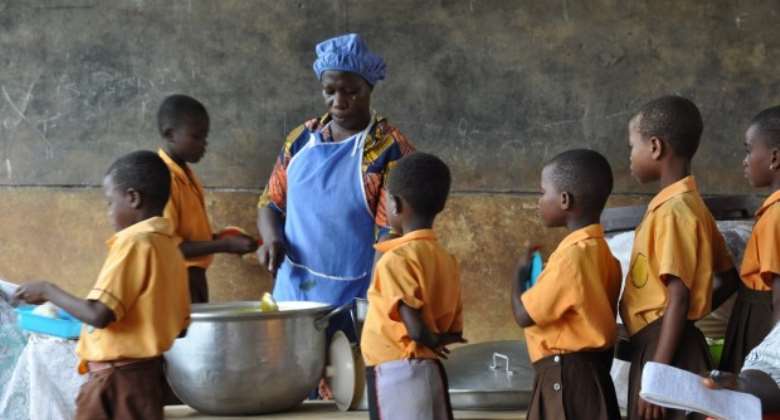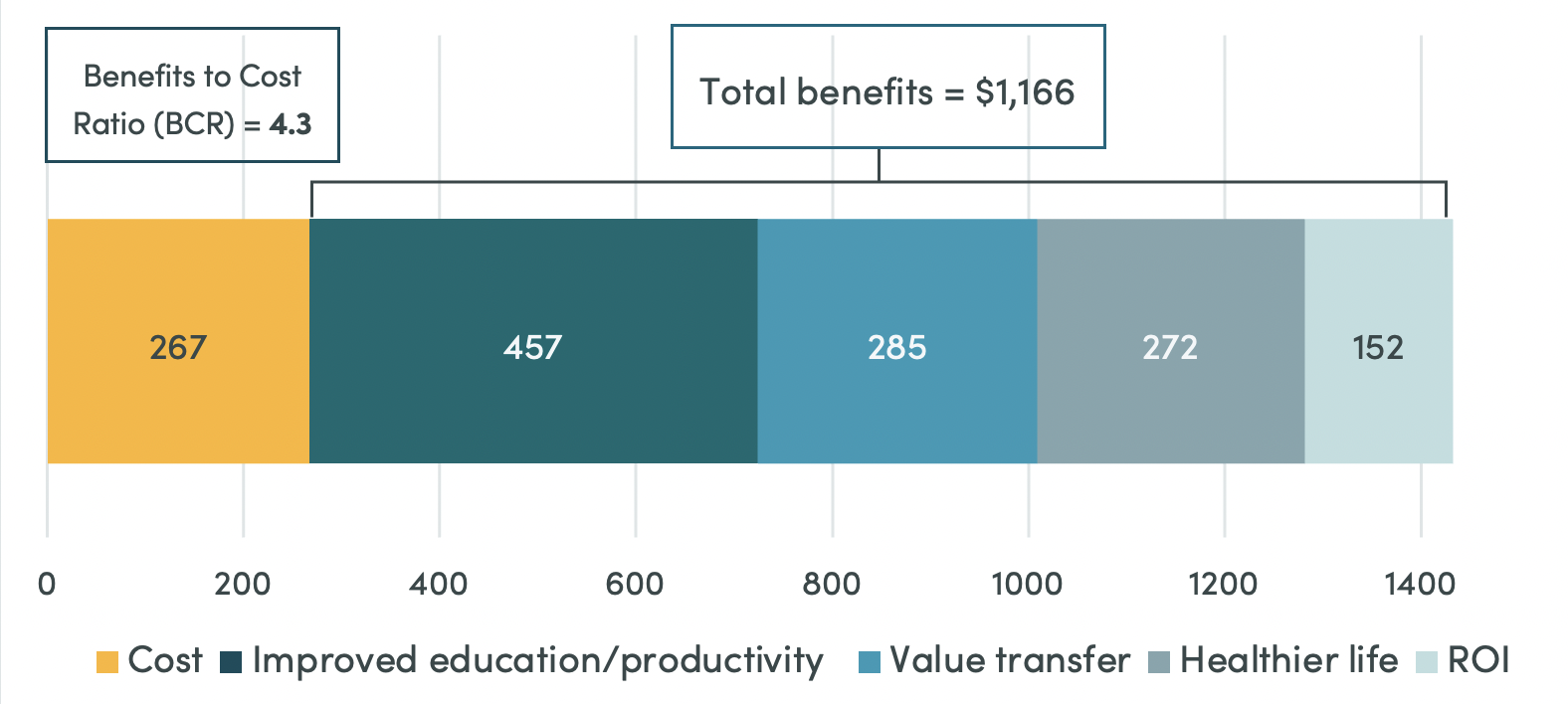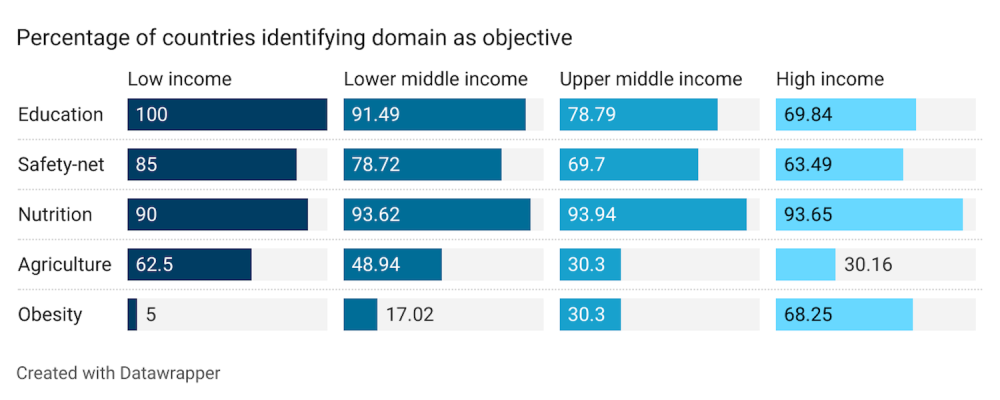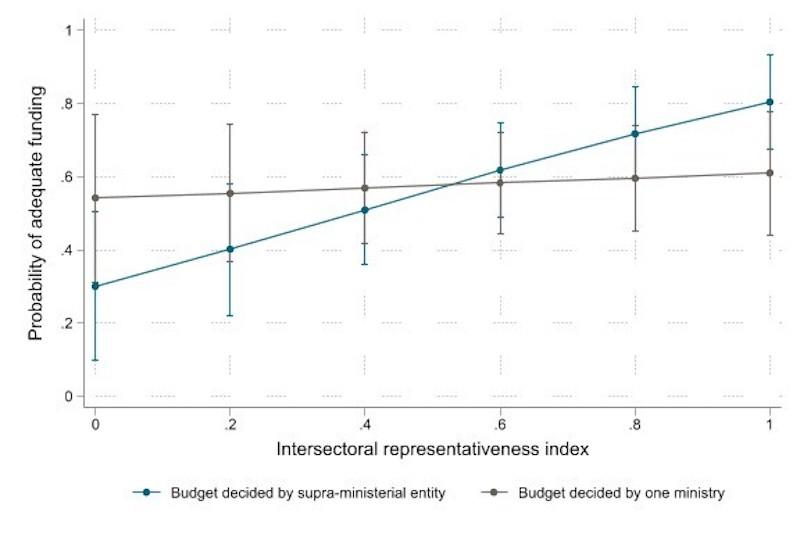Recommended
School feeding is one of those social policy interventions that are hard to pigeonhole in traditional sectors. The benefits span various facets of the beneficiaries’ lives and the local economy. So who should bear the responsibility and cost of provision of school meals? Despite strong political and popular support for school meals in many countries, a misalignment between how the benefits are distributed and where the program is located in the organizational structure and budget framework of governments can hamper progress and endanger sustainability. International donors can also contribute to this misalignment by insisting on conformity to rigid sectoral silos.
Governments see more in school meals than education, or nutrition
I have analyzed data from the most recent survey of 185 school feeding programs across 125 countries conducted by the Global Child Nutrition Foundation (GCNF) to understand the intersectoral features of school meals programs. Countries rely on school feeding programs to achieve various social policy objectives at a given point in time or at different stages in their development. Figure 1 shows the percentage of school feeding programs, by income group, which have identified one of the five main types of objectives often associated with school meals. Even though nutrition is the most common objective across the board, the typical program in a low-income country is intended to achieve at least 3 distinct objectives. The relevance of non-nutrition objectives in school feeding programs increases as income level decreases.
Figure 1: School feeding objectives identified by policymakers (N=185)
The choice of policy makers to leverage school meals to achieve multiple objectives is not without basis in terms of empirical evidence. A recent study of the cost-effectiveness of school feeding programs in 14 countries concludes that the multi-sectoral benefits of school feeding “are several times greater than the returns to public health alone, and that the overall benefit-cost ratio of school feeding programs could vary between 7 and 35”. Similarly, a series of comprehensive investment cases produced by the World Food Program (WFP) for at least 4 countries in Africa and Asia demonstrate that the benefits of school feeding come from multiple areas with the highest contribution attributed to improved education and productivity.
Given the evidence on the multidimensionality of official policy objectives and actual benefits of school feeding programs, it is important to examine the intersectoral nature of the implementation of such programs. Do the organizational structures behind a program actually reflect the composition of objectives the program is intended to achieve? One way to answer this question is to check if government ministries, departments or agencies that are responsible for each domain represented in the declared objective of a school feeding program are involved as key stakeholders in the actual implementation of the program.
Social protection is least represented in school feeding governance despite widespread recognition as an objective
Analysis of GCNF’s program level data shows that education is fairly represented institutionally in school feeding programs. Over 90 percent of programs with an education objective have an education body participating as a “decision maker or provider of technical support or resources”. This is not surprising since many school feeding programs are domiciled in education ministries by default because meals are delivered in schools. Figure 2 shows that the corresponding figures for agricultural development and nutrition objectives are 84 percent and 66 percent, respectively. One area where there is a significant gap in institutional representation is social protection. Among programs that aim to use school meals as a social safety net tool, less than one in four has a government body that is normally responsible for social protection involved as a key stakeholder.
Figure 2: Institutional representation of declared objectives in school feeding programs (percentage of programs, by type of objective)
Overall, around 30 percent of programs have all the domains identified in their objectives represented by a sectoral institution involved as a key stakeholder. On the other end of the spectrum, one in 10 programs is governed by an institutional arrangement involving none of the line ministries responsible for its stated objective. In order to obtain a more complete picture of sectoral representation, I have computed, what I call, an intersectoral representativeness index for all 183 programs in the GCNF data. The index measures the proportion of sectoral domains in a school meals program objective that are represented by a government body participating in the program as a key stakeholder. The median value of the index is 0.66. This means that the governance of the typical school feeding program involves government bodies responsible for two of the three objectives it seeks to achieve.
Better intersectoral representation is associated with adequate financing of school meals programs
School meals programs are likely to benefit in a number of ways when the stakeholders who are making the decisions or providing the resources are sufficiently representative of the range of objectives the program is intended to achieve in the first place. One of the areas that can be impacted by the representativeness of the governance of a school feeding program is adequacy and sustainability of financing. The 2021 round of GCNF survey asks program leaders whether they believe funding for the program in the recently completed school year was adequate to achieve program targets.
My analysis of the potential predictors of the adequacy of funding shows that, as expected, programs in wealthier countries are more likely to be well funded whereas programs that cater to a large number of children are less likely to have adequate financing. However, a crucial finding is that the index of intersectoral representativeness exhibits a positive correlation with funding adequacy. This correlation holds true even when considering country-specific and program-specific characteristics such as per capita income, food price index, and the number of children being fed. For instance, a shift from a governance arrangement in which the participating institutions are representative of only half of the actual objectives of a school meals program to one where all objectives are institutionally represented is associated with a 15 percentage point increase in the probability of securing adequate funding.
Figure 3: Correlation between intersectoral governance and funding adequacy
Note: Total number of observations is 152 programs. The underlying regression controls for per capita GDP, food price index, number of children fed through the program, whether school feeding has a line item in the national budget, and whether program management is decentralized. Standard errors are clustered by country.
But that is not the whole story. Further analysis shows that the positive correlation between intersectoral representativeness and funding adequacy holds only when budgetary decisions are not confined to a particular ministry. Figure 3 shows that the representativeness of the institutional arrangements is of little relevance for funding adequacy when budgetary decisions are already exclusively controlled by one ministry. In contrast, there is room for an institutionally inclusive governance mechanism to make a difference for the adequacy of funding for school feeding when budgetary decisions are taken by higher level entities such as the legislature, head of state or inter-ministerial bodies.
The insights from the above analysis can be relevant for the emerging debate regarding the framing, financing and sustainability of school meals programs in low- and middle-income countries. The argument for framing school meals programs as transfer schemes that provide a safety net and promote human capital development is not new. That is duly reflected in the recognition of social safety-net as one of the objectives of school feeding programs particularly among low-income countries where there is insufficient reliable social protection instruments to reach children. However, it is concerning that government actors responsible for social protection are often absent from the table where school feeding decisions are made. More generally, confining a program that is inherently intersectoral to one or another ministry for budgetary decision is likely to lead to suboptimal allocation of resources. This is something national governments and international donors should consider seriously in the debate on how to make school feeding programs more efficient and sustainable.
Disclaimer
CGD blog posts reflect the views of the authors, drawing on prior research and experience in their areas of expertise. CGD is a nonpartisan, independent organization and does not take institutional positions.
Image credit for social media/web: Adobe Stock










